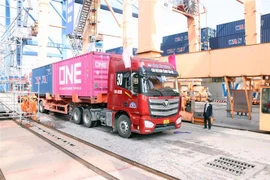According to statistics of the Vietnam MaritimeAdministration (VMA), currently the fleet of Vietnam-flagged cargo ships has nearly 1,050 units, but of which only 38, accounting for 4 percent,are container ships and the number almost kept unchanged in the 2016- 2021period.
At present, Vietnam's import and export transport market ismainly dominated by foreign shipping lines, and the proportion of the domesticfleet is only 6 percent.
Therefore, enhancing competitiveness in the internationalmarket by "rejuvenating" the national fleet is identified as anurgent task at present.
VMA deputy director Nguyen Dinh Viet said that in spite ofserious impacts of the pandemic, the volume of cargo handled by domestic shipsin 2021 is estimated at 156.5 million tonnes, up 2 percent year-on-year.
In the year, Vietnam’s seaports handled over 703 milliontonnes of goods, representing a year-on-year rise of 2 percent. The totalvolume of container cargo going through seaports rose 6 percent year-on-year to23.9 million TEUs.
In late November, the container transport route directlyconnecting Vietnam, Malaysia and India of the Vietnam Maritime Corporation JSC (VIMC)was officially established. Not only shortening the transportation time by 10days compared to the previous transshipment route through Port Kelang ofMalaysia, ships choosing this route can also go directly, without having tocombine with foreign container ships.
This raises hopes for Vietnam to have an intercontinentalfleet, helping goods owners be proactive in importing and exporting goods,instead of depending on foreign shipping lines with costs of 5-7 timeshigher.
However, according to a maritime expert, in the intra-Asiamarket, the average container ship size is about 3,000-5,000 TEUs, whileVietnam's largest container ship is nearly 1,800 TEUs. If the ships are notupgraded soon, it will be difficult for the Vietnamese fleet to survive in theintra-Asia region, not to mention to reach out to the international market./.






























